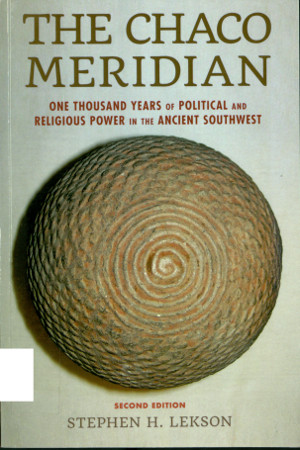Número de ficha: 139339
Me gusta
0
No me gusta
0
Para calificar el registro, es necesario acceder al sistema.
Ir a la página de acceso
- ISBN
- 978-1-4422-4645-4
- Clasificación DEWEY
- 978.9004974 LEK-ch
- Autor
- Lekson, Stephen H. , autor
- Título
- The Chaco meridian : one thousand years of political and religious power in the ancient Southwest / Stephen H. Lekson ; foreword by Ruth M. Van Dyke, Phillip Tuwaletstiwa, and Severin Fowles
- Edición
- Segunda edición .
- Lugar de publicación
- Lanham Boulder New York London Rowman & Littlefield 2015
- Descripción
- xxiii, 257 páginas : ilustraciones ; 23 cm.
- Tipo de medio digital o análogo
- sin medio rdamedia
- Medio de almacenamiento
- volumen rdacarrier
- Bibliografía
- Incluye referencias bibliográficas e índice.
- Nota de Resumen
- In this return to his lively, provocative reconceptualization of the meaning of Chaco Canyon and its monumental 11th-century structures, Stephen H. Lekson expands over time and distance our understanding of the political and economic integration of the American Southwest. Lekson s argument that Chaco did not stand alone, but rather was the first of three capitals in a vast networked region incorporating most of the Pueblo world has gained credence over the past 15 years. Here, he marshals new evidence and new interpretations to further the case for ritual astronomical alignment of monumental structures and cities, great ceremonial roads, and the shift of the regional capital first from Chaco Canyon to the Aztec Ruins site and then to Paquime, all located on the same longitudinal meridian. Along the line from Aztec to Paquime, Lekson synthesizes 1000 years of Southwestern prehistory explaining phenomena as diverse as the Great North Road, macaw feathers, Pueblo mythology, the recycling of iconic symbols over time, founder burials, and the rise of kachina ceremonies to yield a fascinating argument that will interest anyone concerned with the prehistory and history of the American Southwest."
- Fuente de adquisición
- EBSCO ; compra ; 18-01-2018
- Materia
- Anasazis -- Antigüedades
- Anasazis -- Política y Gobierno
- Cultura Mimbre
- Cultura Chaco
- Materia Nombre Geográfico
- Chaco Culture National Historical Park (Nuevo México) -- Antigüedades
- Monumento Nacional de las Ruinas Aztecas (Nuevo México)
- Casas Grandes, Sitio Arqueológico (Chihuahua)
- Autor Secundario
- Van Dyke, Ruth M. , prologuista
- Tuwaletstiwa, Phillip , prologuista
- Fowles, Severin , prologuista
| etiq. | info |
|---|---|
| 000 | aa a a |
| 005 | 20170613223707.0 |
| 006 | a |
| 008 | 150116r20151999mduad rb 001 0 eng |
| 020 | |a978-1-4422-4645-4 |
| 035 | |a139339 |
| 040 | |aDLC|bspa|cDLC|erda|dDLC|dCOLMICH |
| 082 | 00|a978.9004974|bLEK-ch |
| 100 | 1 |aLekson, Stephen H.|eautor |
| 245 | 14|aThe Chaco meridian|bone thousand years of political and religious power in the ancient Southwest |cStephen H. Lekson ; foreword by Ruth M. Van Dyke, Phillip Tuwaletstiwa, and Severin Fowles |
| 250 | |aSegunda edición |
| 264 | |aLanham |aBoulder |aNew York |aLondon|bRowman & Littlefield|c2015 |
| 300 | |axxiii, 257 páginas|bilustraciones|c23 cm. |
| 336 | |atexto|2rdacontent |
| 337 | |asin medio|2rdamedia |
| 338 | |avolumen|2rdacarrier |
| 504 | |aIncluye referencias bibliográficas e índice. |
| 520 | |aIn this return to his lively, provocative reconceptualization of the meaning of Chaco Canyon and its monumental 11th-century structures, Stephen H. Lekson expands over time and distance our understanding of the political and economic integration of the American Southwest. Lekson s argument that Chaco did not stand alone, but rather was the first of three capitals in a vast networked region incorporating most of the Pueblo world has gained credence over the past 15 years. Here, he marshals new evidence and new interpretations to further the case for ritual astronomical alignment of monumental structures and cities, great ceremonial roads, and the shift of the regional capital first from Chaco Canyon to the Aztec Ruins site and then to Paquime, all located on the same longitudinal meridian. Along the line from Aztec to Paquime, Lekson synthesizes 1000 years of Southwestern prehistory explaining phenomena as diverse as the Great North Road, macaw feathers, Pueblo mythology, the recycling of iconic symbols over time, founder burials, and the rise of kachina ceremonies to yield a fascinating argument that will interest anyone concerned with the prehistory and history of the American Southwest." |
| 541 | |aEBSCO|ccompra|d18-01-2018 |
| 598 | |aENERO2018 |
| 598 | |aCEQ |
| 650 | 4|aAnasazis |xAntigüedades |
| 650 | 4|aAnasazis |xPolítica y Gobierno |
| 650 | 4|aCultura Mimbre |
| 650 | 4|aCultura Chaco |
| 651 | 4|aChaco Culture National Historical Park (Nuevo México) |xAntigüedades |
| 651 | 4|aMonumento Nacional de las Ruinas Aztecas (Nuevo México) |
| 651 | 4|aCasas Grandes, Sitio Arqueológico (Chihuahua) |
| 700 | 1 |aVan Dyke, Ruth M.|eprologuista |
| 700 | 1 |aTuwaletstiwa, Phillip|eprologuista |
| 700 | 1 |aFowles, Severin|eprologuista |
| 906 | |a7|bcbc|corignew|d1|eecip|f20|gy-gencatlg |
